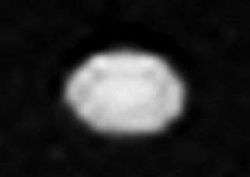Discovery date July 1989 Eccentricity 0.0002 ± 0.0002 Orbital period 8 hours Apparent magnitude 22.0 | Semi-major axis 52 526 ± 1 km Discovered July 1989 | |
 | ||
Discovered by Stephen P. Synnott and Voyager Imaging Team Similar Stephen P Synnott discoveries, Neptune moons, Other celestial objects | ||
Despina moon top 7 facts
Despina (/dᵻˈspiːnə/ di-SPEE-nə or /dᵻˈspaɪnə/ di-SPY-nə; Latin: Despœna,; Greek: Δέσποινα), also known as Neptune V, is the third closest inner satellite of Neptune. It is named after Despoina, a nymph who was a daughter of Poseidon and Demeter.
Despina was discovered in late July 1989 from the images taken by the Voyager 2 probe. It was given the temporary designation S/1989 N 3. The discovery was announced (IAUC 4824) on August 2, 1989, but the text only talks of "10 frames taken over 5 days", giving a discovery date of sometime before July 28. The name was given on 16 September 1991.
Despina is irregularly shaped and shows no sign of any geological modification. It is likely that it is a rubble pile re-accreted from fragments of Neptune's original satellites, which were smashed up by perturbations from Triton soon after that moon's capture into a very eccentric initial orbit.
Despina's orbit lies close to but outside of the orbit of Thalassa and just inside the Le Verrier ring. As it is also below Neptune's synchronous orbit radius, it is slowly spiralling inward due to tidal deceleration and may eventually impact Neptune's atmosphere, or break up into a planetary ring upon passing its Roche limit due to tidal stretching.
The diameter of Despina is approximately 150 km (90 mi) wide.
